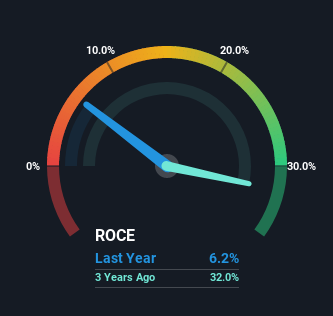- Hong Kong
- /
- Auto Components
- /
- SEHK:6162
China Tianrui Automotive Interiors (HKG:6162) Is Reinvesting At Lower Rates Of Return

Did you know there are some financial metrics that can provide clues of a potential multi-bagger? Typically, we'll want to notice a trend of growing return on capital employed (ROCE) and alongside that, an expanding base of capital employed. Ultimately, this demonstrates that it's a business that is reinvesting profits at increasing rates of return. However, after briefly looking over the numbers, we don't think China Tianrui Automotive Interiors (HKG:6162) has the makings of a multi-bagger going forward, but let's have a look at why that may be.
Understanding Return On Capital Employed (ROCE)
For those that aren't sure what ROCE is, it measures the amount of pre-tax profits a company can generate from the capital employed in its business. To calculate this metric for China Tianrui Automotive Interiors, this is the formula:
Return on Capital Employed = Earnings Before Interest and Tax (EBIT) ÷ (Total Assets - Current Liabilities)
0.062 = CN¥18m ÷ (CN¥572m - CN¥287m) (Based on the trailing twelve months to December 2021).
Therefore, China Tianrui Automotive Interiors has an ROCE of 6.2%. On its own, that's a low figure but it's around the 5.3% average generated by the Auto Components industry.
Check out our latest analysis for China Tianrui Automotive Interiors

Historical performance is a great place to start when researching a stock so above you can see the gauge for China Tianrui Automotive Interiors' ROCE against it's prior returns. If you'd like to look at how China Tianrui Automotive Interiors has performed in the past in other metrics, you can view this free graph of past earnings, revenue and cash flow.
What The Trend Of ROCE Can Tell Us
When we looked at the ROCE trend at China Tianrui Automotive Interiors, we didn't gain much confidence. To be more specific, ROCE has fallen from 18% over the last five years. Given the business is employing more capital while revenue has slipped, this is a bit concerning. This could mean that the business is losing its competitive advantage or market share, because while more money is being put into ventures, it's actually producing a lower return - "less bang for their buck" per se.
On a separate but related note, it's important to know that China Tianrui Automotive Interiors has a current liabilities to total assets ratio of 50%, which we'd consider pretty high. This can bring about some risks because the company is basically operating with a rather large reliance on its suppliers or other sorts of short-term creditors. Ideally we'd like to see this reduce as that would mean fewer obligations bearing risks.
The Bottom Line
From the above analysis, we find it rather worrisome that returns on capital and sales for China Tianrui Automotive Interiors have fallen, meanwhile the business is employing more capital than it was five years ago. And, the stock has remained flat over the last three years, so investors don't seem too impressed either. Unless there is a shift to a more positive trajectory in these metrics, we would look elsewhere.
One more thing, we've spotted 3 warning signs facing China Tianrui Automotive Interiors that you might find interesting.
For those who like to invest in solid companies, check out this free list of companies with solid balance sheets and high returns on equity.
If you're looking to trade China Tianrui Automotive Interiors, open an account with the lowest-cost platform trusted by professionals, Interactive Brokers.
With clients in over 200 countries and territories, and access to 160 markets, IBKR lets you trade stocks, options, futures, forex, bonds and funds from a single integrated account.
Enjoy no hidden fees, no account minimums, and FX conversion rates as low as 0.03%, far better than what most brokers offer.
Sponsored ContentNew: AI Stock Screener & Alerts
Our new AI Stock Screener scans the market every day to uncover opportunities.
• Dividend Powerhouses (3%+ Yield)
• Undervalued Small Caps with Insider Buying
• High growth Tech and AI Companies
Or build your own from over 50 metrics.
Have feedback on this article? Concerned about the content? Get in touch with us directly. Alternatively, email editorial-team (at) simplywallst.com.
This article by Simply Wall St is general in nature. We provide commentary based on historical data and analyst forecasts only using an unbiased methodology and our articles are not intended to be financial advice. It does not constitute a recommendation to buy or sell any stock, and does not take account of your objectives, or your financial situation. We aim to bring you long-term focused analysis driven by fundamental data. Note that our analysis may not factor in the latest price-sensitive company announcements or qualitative material. Simply Wall St has no position in any stocks mentioned.
About SEHK:6162
China Tianrui Automotive Interiors
An investment holding company, engages in the research, development, manufacture, and sale of automotive interior and exterior decorative components and parts in the People’s Republic of China.
Adequate balance sheet low.
Market Insights
Community Narratives



